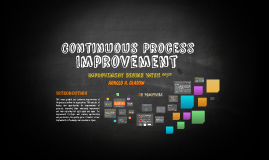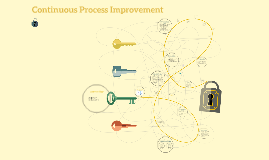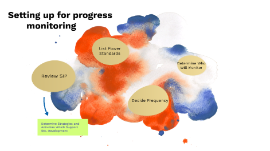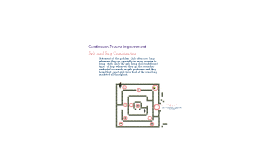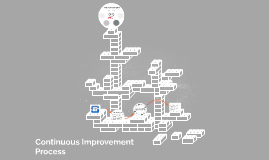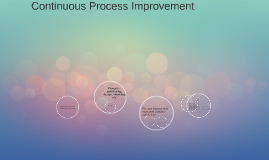Continuous Process Improvement
Transcript: Steps in enabling neatness in the organization Eliminating waste, strain and discrepancy – Kaizen is achieved through application of 5S tools for workplace effectiveness and elimination of three MUs. a. Everything should have a name. b. A place for everything and everything in its place c. Quick identification and retrieval mechanism d. Safe storage/ transfer e. Height consideration for the storage of items depending on the frequency of their use. Shitsuke (Standardize) • Machinery • Techniques • Facilities • Tools and jigs • Thinking 1. Work place effectiveness 2. Elimination of waste, strain and discrepancy 3. Standardization Whether it is a Kaizen Blitz or Kaizen in the traditional sense, it involves the following: Seiri (Sort) KAIZEN PDCA AND 7 QUALITY TOOLS • Application of 5S for improving workplace effectiveness. • Reduction and finally elimination of three MUs. • Standardization of effective methodologies for carrying out the work. • Productivity improvement of 40 per cent • Work In Progress (WIP) reduction of 70 per cent • Machine set up time reduction of 30 per cent • Space reduction for manufacturing by 40 per cent and no additional capital investment Overproduction Waste A typical improvement process using Kaizen is indicated in fig. 8.2 an effective means for systematic workplace organization. a self-contained and understandable instruction, painted neatly at the right place. This happens if the person does not have the map. To add value by every motion of the employee and machinery. The aim of BUSINESS PROCESS REENGINEERING (BPR) is to make dramatic improvement in quality. It is a fundamental component and one of the tool to achieve TQM approach. Therefore, Total Quality Management is not only continuous improvement because it has many facets as given in the various chapter. It is the means to achieve BPR. BPR is a tool, while TQM is an umbrella concept involving many other strategies. Standardization - Kaizen stresses standardization of process, materials.ect with the following objectives. • Human resources • Production volumes • Inventories (materials) • Time • Working place The improvement function aims at revising the current standards. Kaizen is different from innovation. Innovation aims at dramatic improvement of the existing processes, whereas, Kaizen aims at small, incremental improvement in the existing processes. BPR is “the fundamental rethinking and radical redesign of business processes to achieve dramatic improvement in critical, contemporary measures of performance, such as cost, quality, service and speed.” THANK YOU! Kaizen Implementation BUSINESS PROCESS REENGINEERING (BPR) GOALS OF KAIZEN Improvement without capital investment It should be the discipline on the part of the employees, follow the rules, which they made for themselves. Watts Humphrey says, “The purpose of driving is to reach the destination on time and not to spin the wheel.” 1. Planning 2. Process Study 3. Study of the best practices 4. Redesign 5. Implementation BPR is synonymous with innovation because it is more than just automating or automating or applying Information Technology to the existing process or operations. Step 3: Be consistent in following the rules. 3. Following three random audits and on the basis of the audit report, eligibility of the 5S Certification will be considered. 4. A certificate will be awarded by NPCC and Kaizen Institute (Africa, Asia and Pacific) to any organization, which has successfully implements the practices. Maintenance involves activities directed at maintaining current technological, managerial and operating standards. While efforts are going on for improving the processes, the present activities should continue as per the current standards without any interruption. Categories in classifying items: Separate tools, machinery, products, inspection, work in progress, and documentation into necessary and unnecessary and discard unnecessary items. 5S PRACTICES Offers by National Productivity and Competitiveness Council (NPCC) of Mauritius. Introduced in April 2002. Aimed at developing and assisting the productivity culture across Mauritius. 1. The team of 5 auditors will audit the Gemba (work place) proposed for certification. 2. The audited organization should keep the following relevant information. • Maintenance • Improvement Dramatic improvements can take place through elimination of redundant operations, unnecessary operations and operations, which add cost, but, not value to the products and services. INTRODUCTION Juran brings out that good financial results are achieved in an organization through three managerial processes namely, planning, control and improvement. Juran suggests similar analogy for better quality results. The quality trilogy consists of the same three managerial processes and aimed at improving quality of products and services. occurs due to failure of production planning when money is blocked in the unsold products. Just-In-Time (JIT) is the






